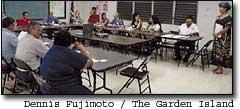KILAUEA — They came to find out. They listened. And, they agreed that they would need to take it back to members of various organizations they represented. About two dozen residents from Kilauea showed up for the organizational meeting of
KILAUEA — They came to find out.
They listened.
And, they agreed that they would need to take it back to members of various organizations they represented.
About two dozen residents from Kilauea showed up for the organizational meeting of the county’s Waele A Ola Hou anti-drug program for that town recently.
Moderated by Bev Pang and Roy Nishida of the county’s anti-drug office, the representatives were not alone as, among the group were residents, some of whom had frustrations with policing efforts and policies, and some of whom have actually gone through problems with ice.
“We came because you said, though the Ka Leo meetings, you had a problem,” Pang said following the introduction of the group members.
The Waele A Ola Hou, a program with a strategy modeled after the U.S. Justice Department’s highly successful Weed and Seed program, might be a solution to the community’s problem, Pang said.
Nishida explained that Kaua’i’s communities are too small to qualify for funding and other help under national standards, but after consulting with officials with the U.S. Justice Department, County of Kaua’i officials got consent to model a program using their successful guidelines. Initially, three communities on Kaua’i have been targeted for this program (Kilauea, Hanama’ulu and Kekaha).
Nishida said the Waele A Ola Hou program fits one of the priorities of the drug plan that was adopted in 2004, the translation of the program’s Hawaiian title being “to plant seeds for a new beginning.”
The second major issue that is being addressed through the drug plan is the establishment of an adolescent drug-treatment house in Hanapepe, and the third fork establishes a parenting class which, Pang said, “is by parents, for parents,” and is being held in partnership with leaders with the state Department of Education.
Leaders in Kekaha, the first of the three communities, have hit the ground running, Pang said. They’ve already gotten organized, held several functions, and are hosting their second meeting.
The third community is Hanama’ulu, whose leaders held their organizational meeting yesterday, Monday, Sept. 26, at the King Kaumuali’i Elementary School cafeteria.
These three targeted communities represent areas in the West, East, and Central areas of the island.
Throughout the various Ka Leo meetings, Pang said the top two problems that were raised islandwide included speeding and drugs.
Weeding through the rhetoric, Pang said one of the functions of the program is not to add another meeting, but, instead, to identify the efforts of the various community groups, and to get people to start working together to solve the problem.
Waele A Ola Hou is a community-driven program consisting of four collaborative arms: neighborhood restoration; law enforcement; prevention, intervention and treatment; and community policing.
Pang noted the enthusiastic response by Kekaha residents and leaders of organizations in quickly identifying areas they were weak in, and taking steps to strengthen those weaknesses.
Some of those in attendance quickly identified with the points, noting the lack of police visibility in Kilauea. One resident brought out the point that she doesn’t bring her family to certain areas anymore due to the gathering of people unconducive to the rearing of children.
The goal of Waele A Ola Hou is to develop a comprehensive, community-based strategy designed to control and prevent violent crime, gang activity, drug trafficking, and drug-related crime.
Once in place, ola hou, or seed of new life and healing, will see the neighborhood improve, revitalize, and restored.
Pang said the first step is to take back control of the neighborhood.
Part of the coordination effort is to maximize the impact of leaders of various governmental agencies in Kilauea town. This is done by getting to understand the objectives of leaders of each organization, eliminating over-lapping or duplicating efforts, and matching up the organizations to better service the community.
Pang said that, working with the Ka Leo program, there are activities available for residents, and under the drug master plan, a lot of the work has already been done.
Some of the ways the community can become involved in community policing, one of the arms of the program, include foot and bicycle patrols, establishment of a mini police station, making victim referrals to officials of appropriate support-service agencies, nuisance-abatement programs, community mobilization, neighborhood watches, citizen marches, rallies, prayer services, the establishment of drug-free zones, and the removal of graffiti.
Pang noted that the success of the Ewa Beach program demonstrated the effectiveness of the suggestions, as some facets were publicized by the media in the community’s battle to take back their neighborhood.
Another step towards reclaiming the community comes in neighborhood restoration, where the community is improved and revitalized through the identification of and response to social-service needs.
This requires the coordinated use of federal, state, local, and private-sector resources. Some of the strategies involve economic development, employment opportunities for residents, and improvement of the housing stock and physical environment of the neighborhood.
Restoration activities include renovating and refurbishing housing and commercial establishments, improving public spaces, parks, and recreation facilities, and creating a solid economic foundation for entrepreneurship and job creation.
Pang explained that communities whose members are empowered to solve their own problems function more effectively than those in communities who depend on services provided by outsiders.
As an example, she cited that home owners take care of their property, and as such the program is designed to present solutions based on ownership.
In order for the program to succeed, a community-driven partnership between residents, and leaders of churches, schools, clubs, youth groups, nonprofit organizations, businesses, government, and other agencies needs to be established.
This said, the various representatives agreed to take back the package to their respective groups to mull over.
For more information, please call 241-6392.


